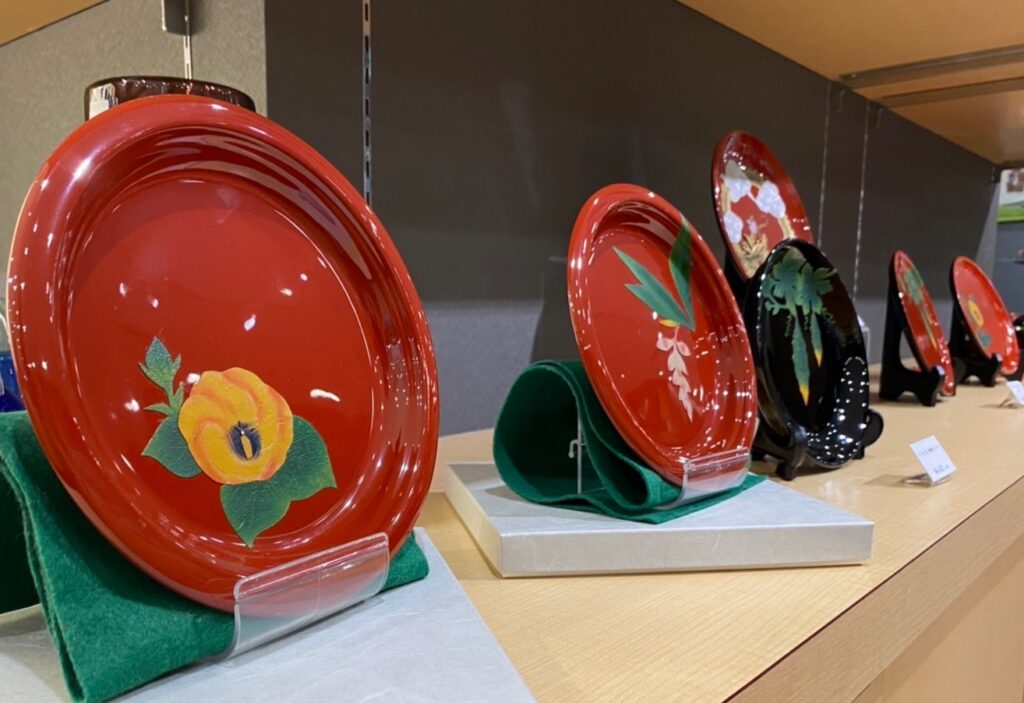Ryukyu Lacquerware

In Okinawa, lacquerware is called nuimun.
The three most common nuimun items are tōtōme (spirit tablet), jūbaku (multi-tiered box) and binshī (small box), traditional craft items for rituals of ancestral worship.
Lacquerware produced in Asia uses the sap of lacquer trees unique to Japan, China, Korea, and the mainland regions of Southeast Asia. Humans have used lacquer sap for thousands of years as paint, adhesive, and even for its waterproofing and insect-repelling properties. However, this exceptional functionality has now been almost forgotten, and people simply consider lacquerware to be an expensive, old-fashioned craft. Such items have become uncommon in our daily lives, a trend that has also been seen in Okinawa.
The Ryukyu Kingdom was once a great producer of lacquerware. In “Ming Shilu (Veritable Records of Ming Dynasty),” there is a record from around six centuries ago of Ming envoys coming to Ryukyu to purchase lacquerware, reflecting a long history of trade.
Most of the lacquerware made in the Ryukyu Kingdom was sent overseas, either as trade items or as gifts and offerings to Chinese emperors, Japanese shoguns, and feudal lords. For this reason, many of these items were long thought to have been made in China. Such items were destined to leave Okinawa, unlike craft items such as bingata textiles and Tsuboya ware, which were made and used only in Ryukyu.
The Ryukyu government established a magistrate’s office called Kaizuri Bugyosho, and under their supervision, highly skilled artisans created beautiful lacquerware items, including tables, paper containers, inkstone cases, food containers, and trays, to showcase the Kingdom’s supremacy and support its economy. Chinese-style items were created for the Ryukyu’s royal family and high-ranking officials and included thrones, twundābuns (large trays with lids) and kufan (two-tiered circular trays).
The lacquerware artisans developed numerous techniques: chinkin (gold inlay), curved patterns with gold foil applied to the lines; raden (mother-of-pearl inlay), patterns created with the inner shells of marbled turban and abalone; hakue (foil painting), patterns painted with lacquer and finished with gold foil on top; and urushi-e (lacquer painting), painting with colored lacquers. Today, the most popular technique is tsuikin (lacquer embossing), which shows the strong influence of Chinese lacquerware. The process involves mixing lacquer with pigments and then making it into a thin sheet. Patterns are then cut out and applied to the surface of items, giving the lacquerware a three-dimensional effect. Tsuikin can also be mass-produced, making it the most widely used technique in contemporary lacquerware production.
There has been a widespread misunderstanding that Ryukyu lacquerware involved the use of pig blood to make vermillion surfaces more vivid. Although pig blood was used in lacquerware production, it was only adopted as the base coat, due to its coagulative effect, which didn’t actually influence the surface colors. While this method was popular during the Meiji period, it is no longer practiced today.
The lacquer works from the Ryukyu Kingdom can be seen at Urasoe City Art Museum in Urasoe, which specializes in Ryukyu lacquerware, as well as Shuri Castle, where the lacquer has been used for decoration, and Okinawa Prefectural Museum, both of which are in Naha.









































































































































































































































